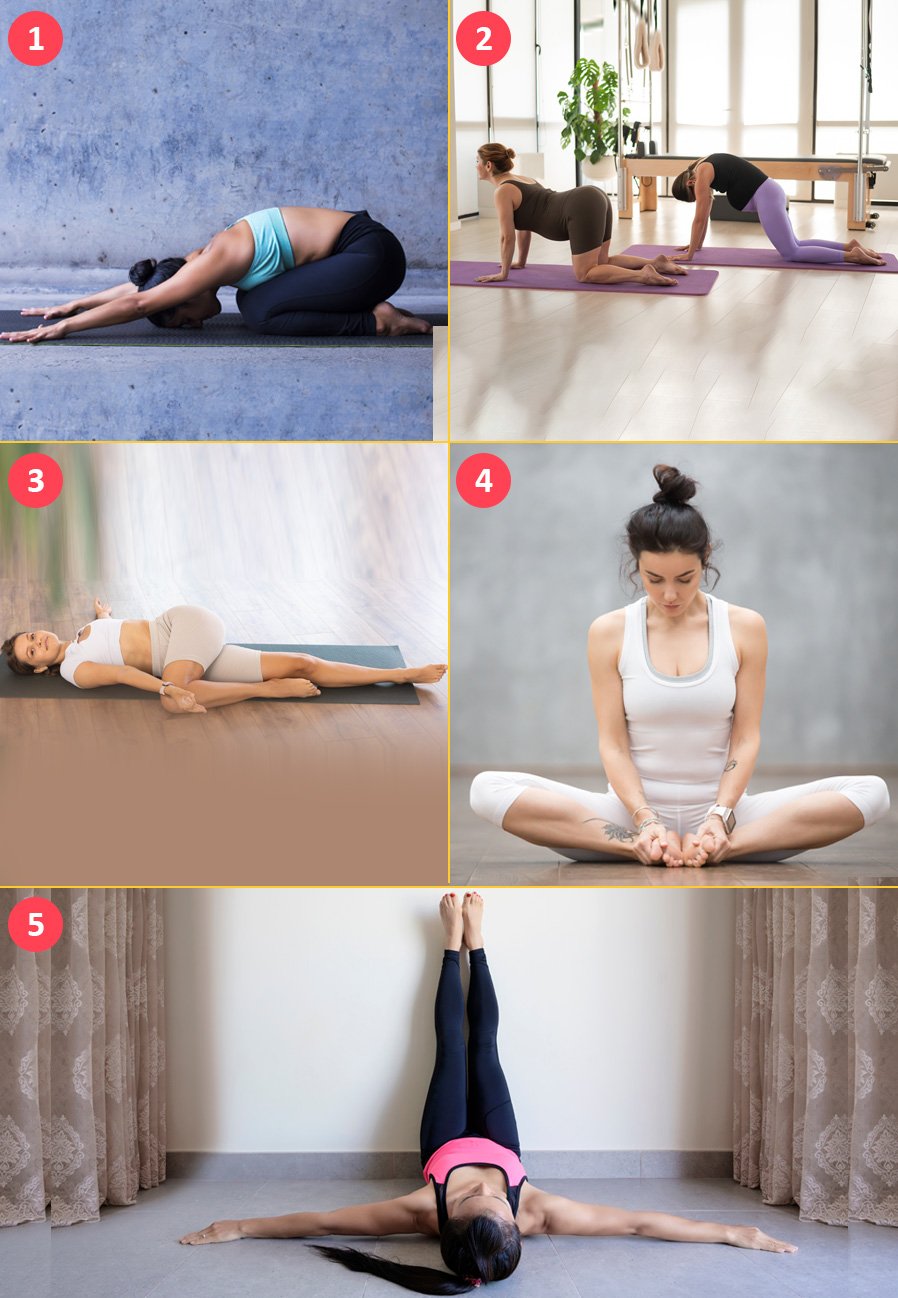Periods often tend to bring with them an unwelcome combination of cramps, bloating, tiredness, and mood swings, and the last thing you may feel like doing is exercising. However, what if we informed you that a few minutes of yoga can actually make you feel much better about that ache?
While heavy exercise is probably out, a light yoga session on your period can work miracles. From enhanced blood flow and ease of stomach cramps to mood balancing and alleviated fatigue, yoga provides a natural, soothing means to feel improved on your period.

Also Read: Yoga For Dysmenorrhea: Bid Goodbye To Menstrual Cramps With These Spectacular Poses
So, if you are questioning whether or not it is okay to do yoga on your periods; the answer is a huge yes! The secret is to be mindful of your body and select restorative, low-intensity poses.
Below are 5 calming, expert-approved yoga poses to help you glide through your cycle with greater ease and comfort.
Is Yoga Safe During Periods?
Yes, yoga is typically safe on your period, particularly when you opt for gentle, restorative postures. These poses alleviate typical menstrual symptoms such as lower back pain, pelvic pain, mood swings, and bloating. Nevertheless, it is advisable to steer clear of inversions (such as headstands or shoulder stands) that cause an inverted blood flow, because they can disrupt your natural cycle.
Also Read: Menstrual Worries: 5 Different Period Problems And Their Ayurvedic Remedies
5 Soothing Yoga Poses To Try During Your Monthly Cycle
During your period, your body needs rest, relaxation, and gentle movement. The following yoga poses are restorative, low-impact, and easy on the body, making them ideal for managing menstrual discomfort like cramps, fatigue, and emotional fluctuations. These poses encourage circulation, reduce bloating, and support hormonal balance, without putting undue stress on your system.

Child’s Pose (Balasana)
How to do it?
Sit on your heels with knees wide apart, stretch your arms out in front of you, and put your forehead on the mat. Breathe and hold this position for 1–3 minutes.
Tip: Put a pillow underneath your chest for additional comfort.
Benefits:
This grounding pose is ideal for when you are low on energy or have cramps in your abdomen. It lightly stretches the hips, thighs, and lower back while soothing the mind.
Cat-Cow Stretch (Marjaryasana–Bitilasana)
How to do it?
Come down on all fours with hands under the shoulders and knees under the hips. Breathe in while arching your back and lifting your head (cow pose), and breathe out while rounding your spine and tucking your chin (cat pose). Continue for 8–10 cycles.
Benefits:
This smooth flowing movement between two poses loosens tight abdominal and back muscles, releasing tension and helping to enhance spinal mobility. It also aids digestion and helps relieve mild bloating.
Supine Spinal Twist (Supta Matsyendrasana)
How to do it?
Lie down on your back, bend one knee and pull it to your chest, and slowly bring it across your body while keeping your shoulders on the ground. Stretch out the other arm and look in the opposite direction. Hold for 30–60 seconds and switch sides.
Benefits:
This reclined twist is wonderful for giving a massage to the organs in the abdomen, which can relieve cramps, gas, and slow digestion commonly felt during menstruation. It also releases tension in the lower back.
Bound Angle Pose (Baddha Konasana)
How to do it?
Sit on the ground, bring soles of your feet together, and allow your knees to drop to the sides. Sit upright and inhale deeply. You may flap your knees gently or lean forward to stretch more deeply. Hold for 1–2 minutes.
Benefits:
Also referred to as the butterfly pose, this asana opens the hips, groin, and inner thighs and eases tension in the pelvis. It increases blood flow to the reproductive area and aids the ease of discomfort.
Legs-Up-the-Wall (Viparita Karani) (optional based on flow)
How to do it?
Sit near a wall and lean back, lifting your legs up so that they are standing vertically against the wall. Place a folded blanket or cushion under your hips for support. Close your eyes and stay here for 5–10 minutes.
Benefits:
This calming inversion decreases water retention in the feet and legs, relaxes the nervous system, and induces deep relaxation. It is particularly comforting for women who feel cranky or drained on their period.
Note: Not recommended if you have heavy bleeding or pain.
These postures are all designed to uphold your body in menstruation physically and emotionally. The thought isn't to force yourself but to respect your body's needs, allow space for healing, and re-balance with each breath.
More Tips for Practicing Yoga During Periods:
Utilize yoga props such as cushions or yoga blocks to support your body.
Maintain slow and deliberate movements.
Drink water prior to and following your yoga practice.
Don't push yourself into any position, comfort is the priority.
If you are dizzy or exhausted, take a break.
Conclusion
Menstruation is a normal aspect of life, and with the proper approach, it need not stall your well-being. Gentle, restorative yoga practice during menstruation can assist you in dealing with discomfort, remaining active, and feeling more in sync with your body. It is not about challenging yourself, it is about respecting your cycle and nurturing your body as much as it needs.
So roll out your mat, breathe in, and flow through your cycle with compassion. Your body will thank you.
Frequently Asked Questions
Can I do yoga on heavy flow days?
Yes, but keep to light stretches and don't do intense or inverted postures. Listen to your body.
Which yoga poses should I not do during menstruation?
Steer clear of inversions (such as shoulder stands or headstands) because they can interfere with normal blood flow.
Does yoga alleviate period cramps?
Yes! Gentle yoga poses enhance circulation, release muscle tension, and assist in lessening menstrual cramps naturally.
For how long do I practice yoga during my period?
Even 10–20 minutes of gentle yoga can contribute. Take your own pace.
Is skipping yoga during periods acceptable if I am too tired?
Yes. Rest is equally essential. Do what is best for your body, no pressure.
(This article is reviewed by Kalyani Krishna Chief Content Editor)
Author Profile
Soumita Basu:
Soumita Basu holds a Bachelor’s Degree in Pharmacy and is keenly interested in Ayurveda, home remedies, yoga, fitness, diagnostics, and beauty. With nearly 6 years of experience, she produces evidence-based health content, including articles, videos, and infographics, to provide valuable insights to her audience.
References:



 Previous
Previous